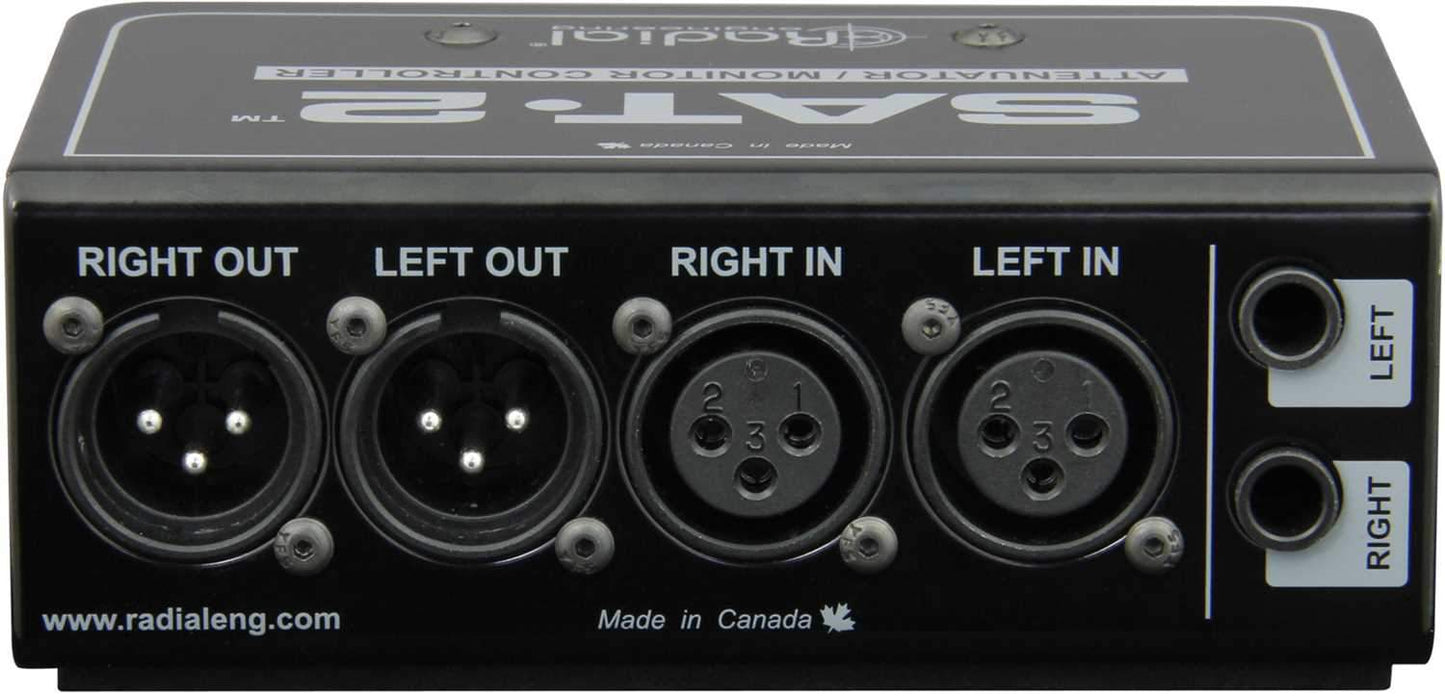Radial SAT2 Line Level Passive Stereo Attenuator
Stereo Audio Attenuator & Monitor Controller
The SAT-2™ is a passive stereo audio device that provides you with a transparent level control wherever you may need it, either at the output of a pair of high-gain mic preamps, or between your recording interface and a pair of powered speakers as a compact desktop monitor controller.
Ultra-quiet monitor controller
When using the SAT-2 as a monitor controller, simply connect it in between your playback device and a pair of powered speakers for an easy-access master volume control. Mute and mono switches allow you to silence the outputs or check mixes for mono phase compatibility, while a handy dim switch with adjustable level control allows you to temporarily lower the output volume without losing the main volume setting.
Attenuation in the studio
The SAT-2 can also be used to attenuate signals before sending them to your audio interface, so you can drive your mic preamps hard for coloration without clipping the inputs of the digital audio converter. A high quality 4-pole rotary knob ensures consistent L-R tracking over the entire range of the trim pot, fully maintaining the left-right balance of stereo sources.
SAT-2 Applications
Use the SAT-2 as a monitor controller
Connect between your audio interface and powered speakers, utilizing the level control as well as the dim and mute switches.
Attenuate the output of a hot mic preamp or compressor
Use the trim control on the SAT-2 to avoid overloading or clipping the inputs of your recording device, while retaining the character of your preamps cranked up to their sweet spot.
Use the SAT-2 for parallel effects processing
Take the output of a mic preamp into the SAT-2, engage the mono switch, and connect one of the SAT-2 outputs directly to your recording interface, and the other to an effects device and then to a second recording track. You can then adjust the blend between the two tracks in your DAW.
Features:
- Level control for a pair of powered speakers
- Attenuates hot signal levels to prevent clipping
- Passive audio circuit, no power required
- Transparent operation without signal coloration
- Mono
Sums the left and right outputs to mono.
- Mute
Silences the outputs of the SAT-2.
- Master
Sets the overall output level. Passes signal at unity gain (no attenuation) when turned fully clockwise.
- DIM on
Used to reduce output levels temporarily without affecting the setting on the trim control.
- DIM Level
Sets the amount of signal attenuation applied when Dim On is engaged
- Outputs
XLR outputs for a pair of powered speakers or the inputs of a recording interface.
- Inputs
TRS ¼" or XLR inputs are available for the left and right channels.
- Warranty: Radial 3-year, transferable
Specifications:
- Audio circuit type: Passive audio signal path
- Number of channels: 2
- Frequency response: 20Hz to 20kHz
- Dynamic range:>141dB
- Gain:0dB
- Total harmonic distortion: >0.0005% @ 0dBu
- Intermodulation Distortion: >0.001% @ 0dBu
- Phase Deviation: 0° @ 20Hz, 0° @ 1kHz, +2° @10kHz
- Input Impedance: 8 k?
- Output Impedance: 1.8 k?
- Common Mode Rejection Ratio: >80dB
- Noise:-115dBu
- Maximum Input:>+ 26dBu
- Features
- Mono Sum, Level Control
- Input Connectors:XLR, 1/4"
- Output Connectors:XLR
- General
- Construction: 14-gauge steel chassis and outer shell
- Size (L x W x D): 5" x 3.25" x 2" (12.7 x 8.3 x 5cm)
- Weight: 1.5lb (0.68kg)
- Shipping size (L x W x D):6.4" x 4.25" x 3" (16.3 x 10.8 x 7.6cm)
- Shipping weight: 1.8lb (0.8kg)
- Power:Passive, no power required
- Conditions: For use in dry locations only between 5°C and 40°C
Sums the left and right outputs to mono.
Silences the outputs of the SAT-2.
Sets the overall output level. Passes signal at unity gain (no attenuation) when turned fully clockwise.
Used to reduce output levels temporarily without affecting the setting on the trim control.
Sets the amount of signal attenuation applied when Dim On is engaged
XLR outputs for a pair of powered speakers or the inputs of a recording interface.
TRS ¼" or XLR inputs are available for the left and right channels.
- Audio circuit type: Passive audio signal path
- Number of channels: 2
- Frequency response: 20Hz to 20kHz
- Dynamic range:>141dB
- Gain:0dB
- Total harmonic distortion: >0.0005% @ 0dBu
- Intermodulation Distortion: >0.001% @ 0dBu
- Phase Deviation: 0° @ 20Hz, 0° @ 1kHz, +2° @10kHz
- Input Impedance: 8 k?
- Output Impedance: 1.8 k?
- Common Mode Rejection Ratio: >80dB
- Noise:-115dBu
- Maximum Input:>+ 26dBu
- Features
- Mono Sum, Level Control
- Input Connectors:XLR, 1/4"
- Output Connectors:XLR
- General
- Construction: 14-gauge steel chassis and outer shell
- Size (L x W x D): 5" x 3.25" x 2" (12.7 x 8.3 x 5cm)
- Weight: 1.5lb (0.68kg)
- Shipping size (L x W x D):6.4" x 4.25" x 3" (16.3 x 10.8 x 7.6cm)
- Shipping weight: 1.8lb (0.8kg)
- Power:Passive, no power required
- Conditions: For use in dry locations only between 5°C and 40°C

















